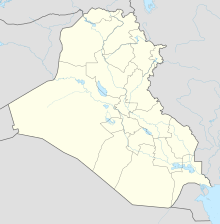
Back عملية أوبرا Arabic Operación Ópera AST Opera əməliyyatı Azerbaijani Operació Òpera Catalan Operace Opera Czech Operation Opera German Επιχείρηση Όπερα Greek Operación Ópera Spanish عملیات اپرا Persian Operaatio Opera Finnish
| Operation Opera | |
|---|---|
| Part of the Arab–Israeli conflict | |
| Operational scope | Strategic |
| Location | 33°12′12″N 44°31′07″E / 33.20333°N 44.51861°E |
| Planned by |
|
| Objective | Destruction of Iraq's Osirak nuclear reactor |
| Date | 7 June 1981 |
| Executed by | |
| Outcome | Israeli operational success
|
| Casualties | 10 Iraqi soldiers, 1 French civilian killed |
Operation Opera (Hebrew: מִבְצָע אוֹפֵּרָה),[1] also known as Operation Babylon,[2] was a surprise airstrike conducted by the Israeli Air Force on 7 June 1981, which destroyed an unfinished Iraqi nuclear reactor located 17 kilometres (11 miles; 9.2 nautical miles) southeast of Baghdad, Iraq.[3][4][5] The Israeli operation came a year after the Islamic Republic of Iran Air Force had caused minor damage to the same nuclear facility in Operation Scorch Sword, with the damage having been subsequently repaired by French technicians. Operation Opera, and related Israeli government statements following it, established the Begin Doctrine, which explicitly stated the strike was not an anomaly, but instead "a precedent for every future government in Israel". Israel's counter-proliferation preventive strike added another dimension to its existing policy of deliberate ambiguity, as it related to the nuclear weapons capability of other states in the region.[6]
In 1976, Iraq purchased an Osiris-class nuclear reactor from France.[7][8] While Iraq and France maintained that the reactor, named Osirak by the French, was intended for peaceful scientific research,[9] the Israelis viewed the reactor with suspicion, believing it was designed to produce nuclear weapons that could escalate the ongoing Arab–Israeli conflict.[3] On 7 June 1981, a flight of Israeli Air Force F-16A fighter aircraft, with an escort of F-15As, bombed the Osirak reactor deep inside Iraq.[10] Israel called the operation an act of self-defense, saying that the reactor had "less than a month to go" before "it might have become critical."[11] The airstrike reportedly killed ten Iraqi soldiers and one French civilian.[12] The attack took place about three weeks before the 1981 Israeli legislative elections for the Knesset.[13]
At the time of its occurrence, the attack was met with sharp international criticism, including in the United States, and Israel was rebuked by the United Nations Security Council and General Assembly in two separate resolutions.[14][15] Media reactions were also negative: "Israel's sneak attack ... was an act of inexcusable and short-sighted aggression",[16] wrote The New York Times, while the Los Angeles Times called it "state-sponsored terrorism".[14][better source needed] The destruction of Iraq's Osirak reactor has been cited as an example of a preventive strike in contemporary scholarship on international law.[17][18] The efficacy of the attack is debated by historians,[19] who acknowledge that it brought Iraq back from the brink of nuclear capability but drove its weapons program underground and cemented Iraqi President Saddam Hussein's future ambitions for acquiring nuclear weapons.
- ^ Perlmutter, p. 172.
- ^ Amos Perlmutter, Michael I. Handel, Uri Bar-Joseph. Two Minutes over Baghdad. Routledge (2nd ed.), 2008. p. 120.
- ^ a b "1981: Israel bombs Baghdad nuclear reactor". BBC News. British Broadcasting Corporation. 7 June 1981. Retrieved 30 November 2010.
- ^ Neff, Donald (1995). "Israel Bombs Iraq's Osirak Nuclear Research Facility". Washington Report on Middle East Affairs. Andrew I. Kilgore: 81–82. Retrieved 30 November 2010.
- ^ Cite error: The named reference
fainbergwas invoked but never defined (see the help page). - ^ Country Profiles -Israel Archived 6 October 2014 at the Wayback Machine, Nuclear Threat Initiative (NTI) updated May 2014
- ^ Ramberg, Bennett. Nuclear Power Plants as Weapons for the Enemy: An Unrecognized Military Peril. University of California Press, 1985. p. xvii.
- ^ Cordesman, Anthony H. Iraq and the War of Sanctions: Conventional Threats and Weapons of Mass Destruction. Praeger, 1999. p. 605.
- ^ Cite error: The named reference
worldbookwas invoked but never defined (see the help page). - ^ Shirley V. Scott, Anthony Billingsley, Christopher Michaelsen. International Law and the Use of Force: A Documentary and Reference Guide. Praeger, 2009. p. 182.
- ^ Scott, p. 132.
- ^ Polakow-Suransky, Sasha. The Unspoken Alliance: Israel's Secret Relationship with Apartheid South Africa. Pantheon (1 ed.), 2010. p. 145.
- ^ Cite error: The named reference
perryIQPwas invoked but never defined (see the help page). - ^ a b Steele, Jonathan (7 June 2002). "The Bush doctrine makes nonsense of the UN charter". The Guardian. Retrieved 29 November 2010.
- ^ Cite error: The named reference
screswas invoked but never defined (see the help page). - ^ "Israel's Illusion". Opinion. The New York Times. 9 June 1981. ISSN 0362-4331. Retrieved 13 February 2023.
- ^ Shue, Henry and Rhodin, David (2007). Preemption: Military Action and Moral Justification. Oxford University Press. p. 215.
- ^ Cite error: The named reference
councilwas invoked but never defined (see the help page). - ^ "Osirak: Threats real and imagined". 5 June 2006.
